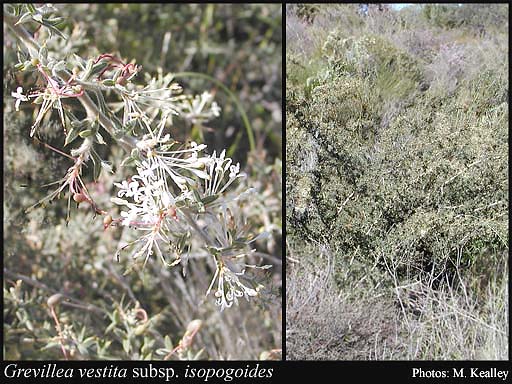- Reference
- New Names Grevillea 16 (1986)
- Conservation Code
- Not threatened
- Naturalised Status
- Native to Western Australia
- Name Status
- Current
Erect, spreading, prickly shrub, 0.6-2(-4.5) m high, up to 3.5 m wide. Fl. white-cream/pink, Mar or May to Sep. Red or yellow sand. Sandplains.







Scientific Description
Shrubs, 1-2 m high; branchlets hairy, not glaucous. Leaves alternate, 10-20 mm long, hairy, on the adaxial or abaxial surface, the hairs straight; lamina flat, once divided, tripartitely divided, deeply divided or divided to the midrib; lobes 4-15 mm long, 1.5-2.5 mm wide, the margins revolute, exposing the lower surface of the leaf blade or enclosing the lower surface of the leaf blade, forming a groove either side of the midvein. Inflorescences axillary or terminal, white or cream; pedicels 7-10 mm long. Perianth 4-5 mm long; tepals all free after flower opens, glabrous; ovary glabrous, stipitate, the stipe 1-2 mm long; pistil 4-5 mm long, white or purple, pollen presenter conical, style glabrous. Follicles glabrous, not viscid, dehiscent, 8-10 mm long. Flowers in June, July, August or September. Occurs in the Eremaean (ER) or South-west (SW) Botanical Province(s), in the Geraldton Sandplains (GS) or Avon Wheatbelt (AW) IBRA subregion(s).
Distribution
- IBRA Regions
- Avon Wheatbelt, Geraldton Sandplains, Yalgoo.
- IBRA Subregions
- Edel, Geraldton Hills, Merredin.
- Local Government Areas (LGAs)
- Chapman Valley, Greater Geraldton, Northampton.